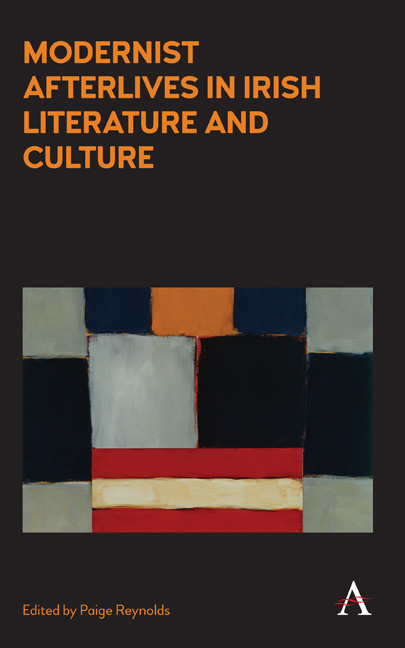Book contents
- Frontmatter
- Contents
- List of Figures
- Acknowledgements
- Introduction
- Section One LITERATURE AND LANGUAGE
- Section Two INSTITUTIONS, ART AND PERFORMANCE
- Chapter 7 ‘Make a Letter Like a Monument’: Remnants of Modernist Literary Institutions in Ireland
- Chapter 8 Storm in a Teacup: Irish Modernist Art
- Chapter 9 ‘Particles of Meaning’: The Modernist Afterlife in Irish Design
- Chapter 10 Animal Afterlives: Equine Legacies in Irish Visual Culture
- Chapter 11 Choreographies of Irish Modernity: Alternative ‘Ideas of a Nation’ in Yeats's At the Hawk's Well and Ó Conchúir's Cure
- Chapter 12 The Modernist Impulse in Irish Theatre: Anu Productions and the Monto
- Afterword: The Poetics of Perpetuation
- Notes on Contributors
- Index
Chapter 8 - Storm in a Teacup: Irish Modernist Art
from Section Two - INSTITUTIONS, ART AND PERFORMANCE
Published online by Cambridge University Press: 22 July 2017
- Frontmatter
- Contents
- List of Figures
- Acknowledgements
- Introduction
- Section One LITERATURE AND LANGUAGE
- Section Two INSTITUTIONS, ART AND PERFORMANCE
- Chapter 7 ‘Make a Letter Like a Monument’: Remnants of Modernist Literary Institutions in Ireland
- Chapter 8 Storm in a Teacup: Irish Modernist Art
- Chapter 9 ‘Particles of Meaning’: The Modernist Afterlife in Irish Design
- Chapter 10 Animal Afterlives: Equine Legacies in Irish Visual Culture
- Chapter 11 Choreographies of Irish Modernity: Alternative ‘Ideas of a Nation’ in Yeats's At the Hawk's Well and Ó Conchúir's Cure
- Chapter 12 The Modernist Impulse in Irish Theatre: Anu Productions and the Monto
- Afterword: The Poetics of Perpetuation
- Notes on Contributors
- Index
Summary
A currach struggles through the Atlantic waves off the Aran Islands in Dorothy Cross's 1997 three- minute video, Teacup (Figure 8.1). Taken from Robert Flaherty's fictional documentary Man of Aran (1934), the grainy black and white footage is contained within the static confines of an ornate china cup, sitting on its saucer. Teacup pays homage to the most famous teacup in modernist art, Meret Oppenheim's Object (Breakfast in Fur), (1936, MoMA). Teacup deploys many of the strategies of its celebrated antecedent by playing on the relationship between masculinity – by depicting fishermen straining their way through the high seas – and femininity – by placing these images within the delicacy and domesticity of the best china. Teacup also mocks the fetishization of the West in Irish culture. Cross's video cleverly subverts the dominant construction of the myth of heroic masculine spectacle located in untamed nature by containing and controlling it within the feminine boundaries of the man-made teacup found in domestic interiors. It thus imparts a sense of the incongruity surrounding the myths of Irish identity.
Nevan Lahart's installation, A Monument to Sub Minimum Wage: A Whiter than White Social GAMA Steak Slave Sandwich (2005), centred on a reconstruction of Vladimir Tatlin's iconic Monument of the Third International. Lahart was inspired by several public disputes concerning the mistreatment of migrant workers in Ireland, including one case in which workers were paid two euros a day and fed on bread and brown sauce. The installation consisted of a wooden tower at the apex of which was a rotating sculpture of a slice of bread. A spiral of slices of toast spelled out the name of the work, with lanterns made from empty bread packets adorning it. It reworked the confrontational strategies of constructivism and Dada in its use of disparate materials and its provocative references to contemporary social and political controversy. When shown at the Eurojet Futures 2005 exhibition at the Royal Hibernian Academy (RHA), the piece caused a mini storm in the Irish media. A prominent Irish bakery threatened legal action due to the publicity generated by the exhibition and fear that it would be mistakenly implicated in the underpayment of workers.
- Type
- Chapter
- Information
- Modernist Afterlives in Irish Literature and Culture , pp. 111 - 124Publisher: Anthem PressPrint publication year: 2016



